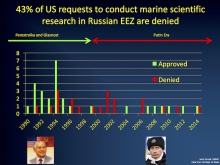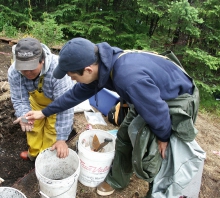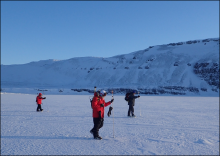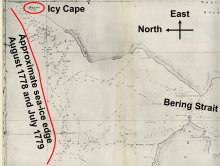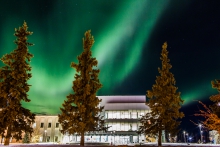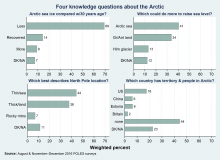Witness Community Highlights is an online publication launched in May 2017 to complement the regular publications of Witness the Arctic. It was developed in response to community feedback identifying the need for a monthly publication to highlight 1–2 Arctic research efforts and other timely items of interest to our readers. Community Highlights is distributed monthly via our Witness the Arctic mailing list of over 8,600 subscribers.
New Agreement to Enhance International Arctic Scientific Cooperation
The eight member states of the Arctic Council vowed to improve cooperation on Arctic science via a legally binding agreement, entitled "Agreement on Enhancing International Arctic Scientific Cooperation” signed on 11 May 2017 at the Arctic Council Ministerial meeting in Fairbanks, Alaska. The goal of this science agreement is to facilitate access, whether to territory and research areas, platforms, infrastructure, facilities, materials, samples, data, or equipment. In the words of Secretary of State Rex Tillerson, the document promises to ease "the movement of scientists, scientific equipment and, importantly, data sharing" across the North. Barriers to research, such as denied visas, the inability to carry equipment and samples across national borders, or denial of access to data, preclude scientific investigation, slow progress, increase cost, and retard the growth of knowledge.
By: John Farrell, Executive Director, U.S. Arctic Research Commission
Archaeology and Pacific Cod Ear Bones Provide Clues on Climate Cycles in the Gulf of Alaska
In a recent study, a team of investigators analyzed oxygen-18 isotopes (δ18O) from the otoliths—or ear bones—from archeological Pacific cod (dating about 1790-1920) to reconstruct nearshore temperature regimes in the Gulf of Alaska. By comparing those values to δ18O levels in fish sampled in the same location in 2004, the team determined that ocean temperatures in the Gulf of Alaska today are about 3˚C warmer than they were during the late Little Ice Age (LIA) two centuries ago. The work was supported by NSF, the National Park Service, and the Oceans Alaska Science and Learning Center in Seward, Alaska.
By: Aron L. Crowell, Alaska Director, Arctic Studies Center, Smithsonian Institution
U. S. Naval Academy Participation in NASA's Operation IceBridge
In mid-March 2017, nine midshipmen and four faculty members from the U. S. Naval Academy (USNA) participated in a joint ice experiment (ICEX) with the NASA Operation IceBridge, an airborne survey program established to mitigate the gap in polar observations between the termination of NASA's Ice, Cloud and Land Elevation Satellite (ICESat) and ICESat-2, scheduled to launch in 2018. The team from USNA were members of the Polar Science and Technology Program, which is an initiative that engages students in technology innovation and introduces them to Arctic environments. The overall goal of the exercise was to collect measurements of snow and ice along the Thule Air Base survey track for validation of NASA Operation IceBridge airborne radar systems. The Thule Air Base track is part of the NASA Operation IceBridge mission inventory. It is revisited each year to monitor snow and ice changes in the polar regions.
By: Commander Shawn Gallaher and Dr. Joseph Smith, U. S. Naval Academy, Oceanography Department
Second Fulbright Arctic Initiative Will Build on Success of 2015-17 Inaugural Program
The U.S. Department of State's Bureau of Educational and Cultural Affairs has announced the launch of the second Fulbright Arctic Initiative, which will run from spring 2018 through fall 2019. This program follows the first Fulbright Arctic Initiative (2015–2017), which was a new multidisciplinary and multinational team research program designed around specific applied research challenges in the areas of water, energy, and health and infrastructure. The first Fulbright Arctic Initiative, which coincided with the U.S. chairmanship of the Arctic Council, was designed to create a network to stimulate international research collaboration on Arctic issues and build the relations between the people of the United States and the people of other countries that are needed to solve global challenges.
By: Lee McDavid, Arctic Program Manager, Institute of Arctic Studies Dartmouth College, Dickey Center for International Understanding
Making Headlines! PolarTREC Teachers Rewarded for their Achievements
In the past 10 years, PolarTREC has provided over 150 U.S. teachers with hands-on experiences with researchers working in the Arctic and Antarctica. In turn, those 150 teachers have reached thousands of students both in and out of their classroom. Data collected through the program evaluation demonstrates that these research experiences impact the teachers long after the initial experience. Every year, PolarTREC teachers are recognized for their dedication to science education. Many have received awards, are featured in the news and present at local and national meetings. These teachers share their experiences as they happen, and carry a new perspective back to the classroom.
Article contributed by Judy Fahnestock and Janet Warburton, Arctic Research Consortium of the U. S.
Captain Cook and the Earliest Historical Charts of the Ice Edge in the Chukchi Sea
Historical documents can provide valuable context for current changes in sea ice and climate conditions. A recent review of the history of sea-ice observations included examination of the journals and charts from Captain James Cook's third voyage as he sailed north through Bering Strait into the Arctic Ocean in search of the Northwest Passage. Cook's documents from 1778 and 1779 provide the earliest historical record of the summer sea-ice edge in the Chukchi Sea.
Article contributed by Harry Stern, Polar Science Center, Applied Physics Laboratory, University of Washington
University of Alaska to Host the 2017 Week of the Arctic
The University of Alaska and the Alaskan Host Committee to the Arctic Council will host the 2017 Week of the Arctic in Fairbanks and Anchorage, Alaska during the week of 8-14 May 2017. The schedule includes a series of events to advance the scientific and technical understanding of Arctic policy, human-environmental interactions, and stakeholder information needs. Contributed by Larry D. Hinzman, Vice Chancellor for Research, University of Alaska Fairbanks. Article contributed by Larry D. Hinzman, Vice Chancellor for Research, University of Alaska Fairbanks.
Arctic Knowledge of the U.S. Public
The most recent nationwide project to assess Arctic knowledge, the Polar, Environment, and Science (POLES) survey, was carried out in two stages in August and November–December of 2016. One unique feature of this survey was its deliberate oversampling of Alaska residents, which allowed a first-time comparison of their Arctic knowledge with that of other U.S. residents. Contributed by Lawrence Hamilton, Carsey School of Public Policy, University of New Hampshire and project colleagues. Article contributed by Lawrence Hamilton, Carsey School of Public Policy, University of New Hampshire and project colleagues


